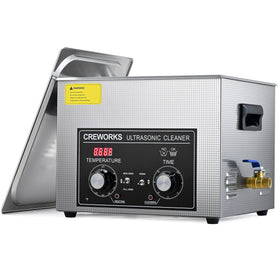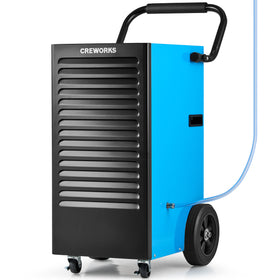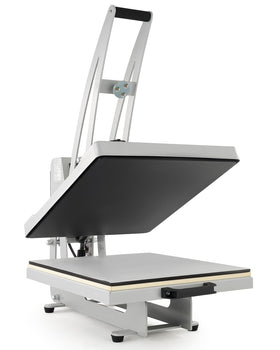With over 10000+ orders
With over 10000+ orders
DTF (Direct-to-Film) printing is basically a high-tech version of temporary tattoos for clothes. You print your design on special film, sprinkle adhesive powder on it while it's wet, cure it with heat, then press it onto your garment. Voilà – custom print without the hassle of screen printing!
HTV (Heat Transfer Vinyl) is completely different. Think of it like cutting shapes out of colored sticker paper. You design what you want, a machine cuts it out, you peel away the extra bits (that's called "weeding"), then use heat to stick it permanently to your shirt.
Both get designs onto fabric, but they're about as similar as texting and sending a letter – same end goal, totally different process. Let's break it down simply.
DTF printing absolutely crushes it when it comes to detail work. Here's what you can expect:

HTV takes a different approach:

Imagine trying to print a detailed sunset photo.
With DTF, you'll see every subtle shade of orange, pink and purple.
With HTV, you'd need to simplify it down to maybe 3-4 distinct color blocks. Not worse necessarily – just different!
Touch matters just as much as looks.
DTF prints feel almost like part of the shirt itself – they're thin, flexible, and move naturally with the fabric. You can barely tell where the print ends and the shirt begins, which makes for super comfortable everyday wear.
HTV has what we call "presence" – you definitely know it's there.
It creates a raised surface that stands slightly proud of the fabric. This isn't a bad thing! Many people actually prefer this effect, especially for sports jerseys and athletic wear where that dimensional look feels more premium.

DTF is like watercolor that soaks into paper, while HTV is more like a sticker applied to the surface. Both look great, but they create distinctly different effects.
Nobody wants their cool new shirt design to crack and peel after a few washes. Here's the real deal on durability:
DTF prints hold up impressively well in the laundry.
Properly applied, they maintain vibrant colors through dozens of wash cycles and don't crack when the fabric stretches. They stay flexible and soft throughout the garment's life.
With HTV, quality matters – a lot.
Premium vinyl can last through many washes, but bargain-basement stuff might start lifting at the edges after just a few cycles. The difference between good and cheap vinyl is like night and day.
Regardless of which method you choose, washing inside-out in cold water and skipping the dryer will double the lifespan of your prints. Your cool designs will thank you!

If you are making just one shirt? The time difference is negligible.
DTF takes about 12-15 minutes from start to finish, while HTV ranges from 10-19 minutes depending on design complexity.
But here's where things get interesting: making multiples.
For a batch of 10 identical shirts:
DTF is like making a cookie cutter. It takes time to create the cutter, but once you have it, stamping out cookies is quick. HTV is more like hand-shaping each cookie individually.
For complex designs, the difference becomes even more dramatic.
An intricate logo with small details might take 5 minutes to weed in vinyl for each shirt – that's an extra 50 minutes on a 10-shirt order that DTF doesn't require!

Both technologies require skills, but they're completely different skill sets.
With DTF, you're essentially becoming a digital printer technician. You'll need to understand color management, humidity control, and proper curing techniques. It's more technical than artistic. Most people need 2-3 weeks of consistent practice before their results are reliable enough to sell.
HTV is more hands-on and craft-oriented. The weeding process – where you remove all the vinyl you don't want – takes patience and dexterity, especially for intricate designs. Most beginners can create basic designs right away, but mastering complex weeding might take several weeks of practice.
This is where DTF really shines.
If the material can handle 15 seconds under a heat press at 350°F, you can print on it. Cotton, polyester, blends, nylon, leather, denim – DTF doesn't care. It works on pretty much everything.
HTV is pickier.
Standard vinyl works fine on cotton and polyester, but specialty materials often require specific vinyl formulations. Want to print on nylon jackets? You'll need special nylon-friendly vinyl. Printing on performance fabric? That requires yet another vinyl type.
For a print shop that handles diverse materials, this difference matters. DTF means having one process for everything. HTV might mean stocking 5-6 different vinyl types to handle whatever walks through the door.

Let's get practical. Here's when each technology makes the most sense:
DTF works best for businesses that:
HTV excels for businesses that:
Many successful businesses actually use both technologies! They'll use HTV for quick one-offs and simple designs, while saving DTF for complex images and larger batches. It's not an either/or situation for established shops.
The right choice ultimately depends on your specific business model, typical orders, available space, and budget. Don't get caught up in having the newest technology if it doesn't match what your customers actually need.
What's your typical order look like? That's the first question you should answer before making your decision.
Which printing method produces better detail and color?
DTF is capable of producing photorealistic, highly detailed images with smooth color gradients and a wide spectrum of colors, making it ideal for complex and colorful designs. HTV is better suited for bold, simple graphics with solid colors but is limited when it comes to fine details or color blending.
How do the prints feel on fabric?
DTF prints are very thin, flexible, and feel integrated into the fabric, making the garment comfortable to wear with almost no noticeable texture. HTV prints have a slight raised or textured surface, which many prefer for sportswear or a premium feel.
How durable are the prints through washing?
DTF prints maintain vibrant colors and elasticity through many wash cycles without cracking or peeling. The durability of HTV depends heavily on the quality of the vinyl used; high-quality HTV can withstand multiple washes, while lower-quality vinyl may start to peel or crack after a few washes.
What materials can each method print on?
DTF works on a wide variety of materials including cotton, polyester, blends, nylon, leather, and denim, as long as the material can handle a heat press. HTV is generally suited for cotton and polyester but requires special vinyl types for materials like nylon or performance fabrics.
How do production efficiency and batch sizes compare?
DTF is more efficient for batch production because most of the work is done upfront, allowing quick transfers to multiple shirts. HTV requires cutting and weeding for each individual shirt, making it slower and less efficient for large orders.
When should I choose DTF or HTV?
Choose DTF if you need complex, detailed designs, work with diverse materials, produce larger batches, or require prints with strong durability. Choose HTV if you are just starting out, mainly print simple designs, produce one-offs or small batches, prefer a textured feel.












Leave a comment